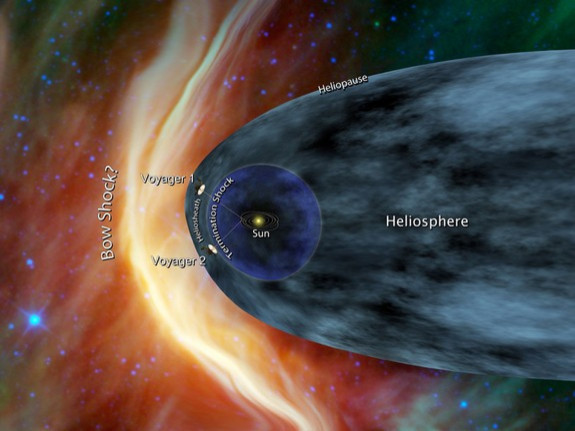First Man-made Object set to Enter Inter-stellar Space; NASA's Voyager 1 Probe May Exit Solar System

NASA's Voyager 1 could exit our solar system by 2012 and go where no man-made object has ever gone, says a new study.
The main mission of both Voyager 1 and Voyager 2 was to study Jupiter, Saturn and their moons. But after 12 years of planetary mission that contributed greatly to scientists' understanding of the solar system, the probes continue to deliver crucial information.
34 years later after its initial launch, the Voyagers are providing insight into the solar system's edge, and one of them is set to enter the edge of the solar system to interstellar space.
The study's lead author Stamatios Krimigis of John Hopkins University's Applied Physics Lab said Perhaps by the end of 2012, we will be out in the galaxy. This timing is earlier than what scientists previously estimated.
Explanation in Layman's Terms
Visualize the solar system as a balloon.
The air inside of the balloon could be seen as the sun's sphere of influence. This is called the heliosphere which is composed of solar plasma and solar magnetic fields.
The balloon's thick skin is the solar sytem's heliosheath, the outer reaches of the solar system.
And finally, there is an outer layer or epidermis of the balloon's skin. This is the solar system's heliopause, the final line between between solar space and the space between the stars.
The Voyager 1 and 2 are currently traveling through the solar system's heliosheath. But recently, Voyager 1 entered into an unknown part of the heliosheath, where the solar wind is zero.
Data from Voyager 1 reveals that the charged particles from the sun dropped from 13,000 mph in 2007 to zero by April 2010 and hasn't gone up since. Researchers are saying that a powerful interstellar wind is causing the solar wind to blow sideways.
Scientists say interstellar space likely begins at 11.3 billion miles from Earth, and the Voyager 1 appears to be almost there.
However, researchers say the heliopause could be anywhere from 10 billion to 14 billion miles from Earth, and are expected to scrutinize future data for signs that the Voyager 1 officially crossed the heliopause.
© Copyright IBTimes 2024. All rights reserved.





















